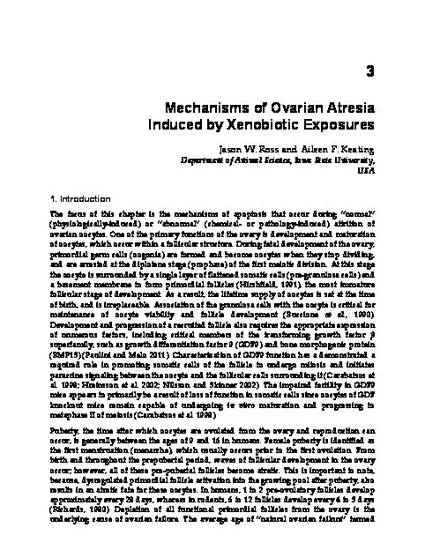
The focus of this chapter is the mechanisms of apoptosis that occur during “normal” (physiologically-induced) or “abnormal” (chemical- or pathology-induced) attrition of ovarian oocytes. One of the primary functions of the ovary is development and maturation of oocytes, which occur within a follicular structure. During fetal development of the ovary, primordial germ cells (oogonia) are formed and become oocytes when they stop dividing, and are arrested at the diplotene stage (prophase) of the first meiotic division. At this stage the oocyte is surrounded by a single layer of flattened somatic cells (pre-granulosa cells) and a basement membrane to form primordial follicles (Hirshfield, 1991), the most immature follicular stage of development. As a result, the lifetime supply of oocytes is set at the time of birth, and is irreplaceable. Association of the granulosa cells with the oocyte is critical for maintenance of oocyte viability and follicle development (Buccione et al., 1990). Development and progression of a recruited follicle also requires the appropriate expression of numerous factors, including critical members of the transforming growth factor β superfamily, such as growth differentiation factor 9 (GDF9) and bone morphogenic protein (BMP15) (Paulini and Melo 2011). Characterization of GDF9 function has a demonstrated a required role in promoting somatic cells of the follicle to undergo mitosis and initiates paracrine signaling between the oocyte and the follicular cells surrounding it (Carabatsos et al. 1998; Hreinsson et al. 2002; Nilsson and Skinner 2002). The impaired fertility in GDF9 mice appears to primarily be a result of loss of function in somatic cells since oocytes of GDF knockout mice remain capable of undergoing in vitro maturation and progressing to metaphase II of meiosis (Carabatsos et al. 1998).
Available at: http://works.bepress.com/aileen-keating/19/

This chapter is published as Jason W. Ross and Aileen F. Keating (February 29th 2012). Mechanisms of Ovarian Atresia Induced by Xenobiotic Exposures, Basic Gynecology - Some Related Issues, Atef Darwish, IntechOpen, DOI: 10.5772/32514.